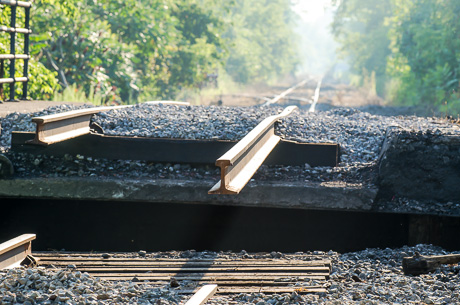
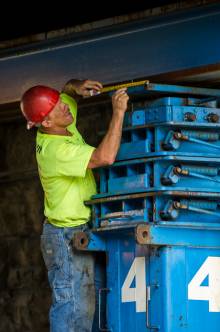 |
Lifting a 255 ton bridge is just as much work as it sounds.
A team of workers put in more than 12 hours yesterday lifting the Genesee Valley Transportation bridge that runs over the south end of Cedar Street -- the ones the trucks always hit -- exactly 36 inches.
Lifting the bridge took a mere 20 minutes. All of the other hours went into getting the hydraulic lifts -- called gantry lifts -- precisely into the their proper locations.
Raising the bridge is part of the Cedar Street reconstruction project. When the project is done, the bridge will provide a clearance of 14' 3" for trucks to pass under.
That's a foot higher than the former height and two feet higher than the sign on the bridge indicated.
The iron bridge was built some time around 1918 for the Lehigh Valley Railroad (the same rail line involved in that train derailment in Le Roy in 1970). It's the last of Lehigh's old line that's still operational. It's just a spur off the main CSX line and is used by GVT to move freight for Chapin Industries.
Rail cars are moved on the line only once every three weeks, meaning the window for lifting the bridge and putting it back in its new place is three weeks.
Yesterday, a crew of five men lifted the bridge.
Watching them do the bulk of the actual labor over a four-hour period was much like watching a well-practiced basketball team weave in and out of a triangle offense.
Few words were spoken and even fewer commands given. Each member of the team knew where he was supposed to be and when and what he was supposed to do.
You would think these men had worked together for years.
That isn't even close to the case said Kevin Seely, project manager for Tonawanda-based Hohl Industrial. It's quite possible this is the first time all five men worked together on the same project at the same time. Only two of the team members had much actual experience together.
That's one advantage, Seely said, of union labor. The workers who are hired for a job already know exactly what they're supposed to do.
All the men -- Seely, Carl Larson, Adam Swanson, Chris Wells and Fred Howry -- told stories of working on bridge lifts all over Western New York, including bigger bridges in Buffalo, bridges that had to be lifted half at a time in Corning, and a bridge in Lockport that was lifted, floated down the canal, turned around and put back in place.
It's not exceptionally dangerous work -- no more so than another other construction work -- but it is work, the kind of work that leaves a man tired, sweaty and grease-and-grime-covered.
It's also precision work.
When you're talking about lifting 255 tons of old iron (weighing a bit less than two jumbo jets), you better make sure the load balances properly. There's little margin for error.
Work started in the morning with laying the rail bed for the gantry lifts. Those had to be perfectly level. Then the lifts were rolled into place. Each of the four lifts -- which are rated for 113 tons each -- had to be measured and placed precisely under the bridge's beams.
Next, two steel beams weighing a few tons each had to be swung into place. Well, swung is too strong of a word. It took an hour for each beam to be meticulously moved onto the lifts, measured, moved, and bolted down exactly where engineers determined they should be placed.
Once in place, hydraulic lines were connected to the lifts and to a control panel so an operator could guide each lift up simultaneously. One lift going up too fast could throw off the load balance.
Before the lift, Howry cut off the dozen or so bolts that were tightened in place more than 100 years ago to anchor the bridge to its rock and cement base.
When workers were ready to start the lift, each jack only went up one inch while other members of the team checked to make sure each of the four corners of the bridge were clearing the base and lined up evenly. Howry thought the second jack needed to come up another half inch, so it was raised to keep everything level.
In looking for a quote about how carefully the operation proceeded, we asked Seely about the process and it put it in pretty obvious terms: "We don't want to drop it or have anything catastrophic happen."
Larson operated the control panel. He then lifted the bridge another 11 inches. It didn't make a sound. No dust or sparks flew. The movement of the bridge was almost imperceptible.
Workers again checked measurements. The bridge had come up with no more than a 1/4-inch variance on any lift.
Larson then started the to lift again, bringing up the bridge to its final 36 inches above its previous location.
The extra space will give construction crews room to operate to build the new seat for the bridge.
Dick Kraft, resident engineer for Erdman Anthony, said high-capacity concrete -- rated for 3,000 psi -- will be poured for a new bridge seat, allowed to cure, and then more concrete will be poured as a new back wall. Once that's cured, the bridge can be lowered to its new seat. And then Chapin can start moving shipments again.
If any of the workers wish to obtain prints of these photos, they can be purchased by following this link.
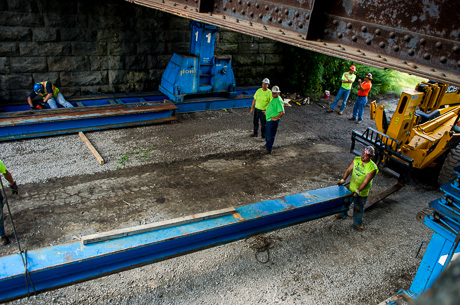
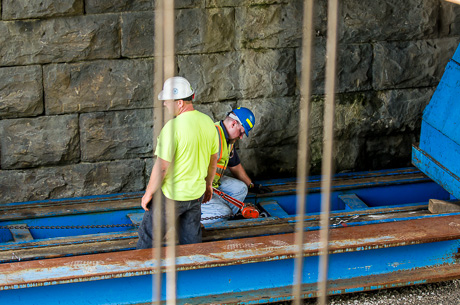
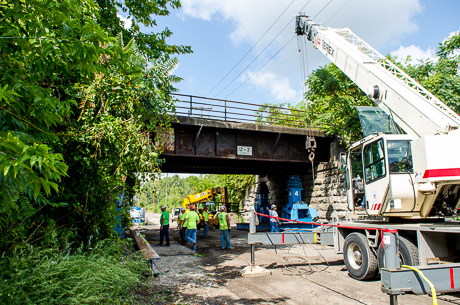
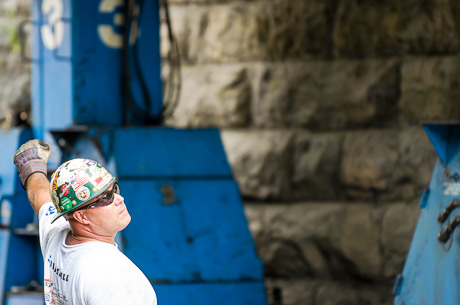
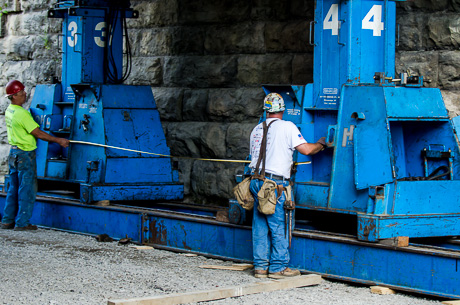
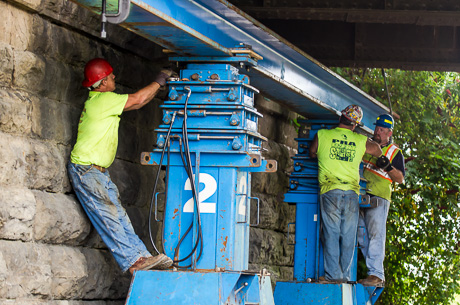
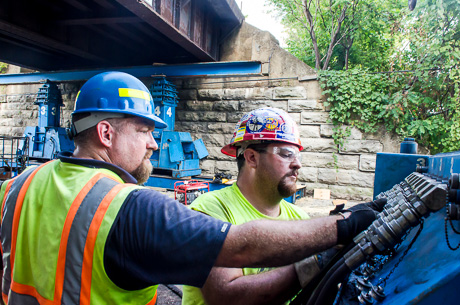
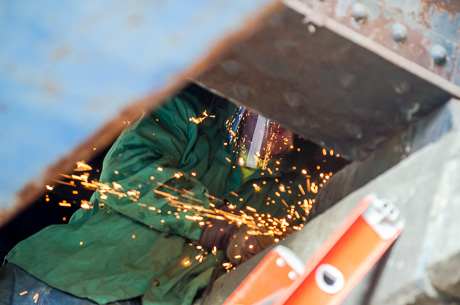
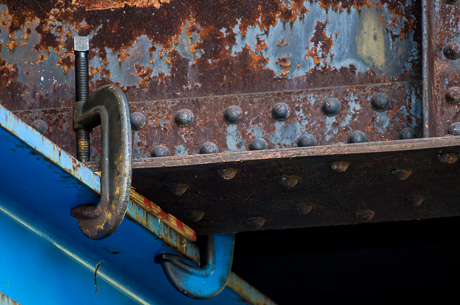
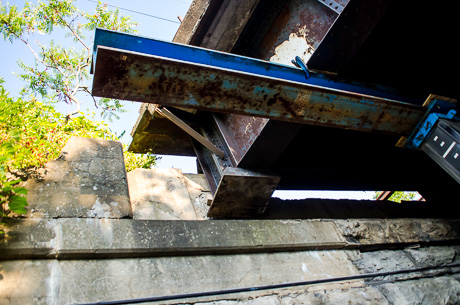
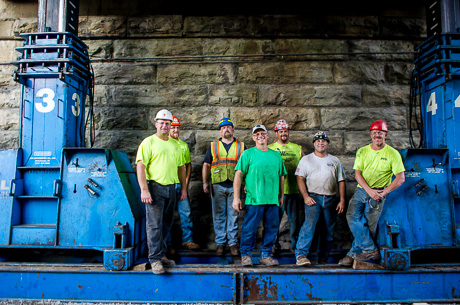
A few of the people involved in Wednesday's operation left before we could do a group picture, but pictured are, from left, Craig Stachowiak, Zoladz Construction, Tom Langiewicz, also with Zoladz, Kevin Seely of Hohl Industrial, Carl Larson, a resident of Boston, Adam Swanson, from Greece and with Iron Workers Local #33, Chris Wells, from Cattaraugus, and Fred Howry, Local #6 and from West Valley.
There's a couple of dozen more photos in the slide show and you can expand them to full screen.

Why not dig out the ground
Why not dig out the ground for the sections leading up to and away from the bridge?
nice write-up and pics
nice write-up and pics Howard!!
Cool!
Cool!
Tyler I can answer that,
Tyler I can answer that, because going below the current grade can lead to ponding issues during downpours. Effectively closing then road and being very dangerous. Remember the last day of July 2012? Check the first picture, if that roadway was 12" deeper you wouldn't even see that blazer anymore..... Heres the pic link
http://thebatavian.com/howard-owens/photos-heavy-rains-bring-localized-…
The bridge abutments only go
The bridge abutments only go down just so far, also. Digging down farther towards the base probably isn't something that should be done.
As long as that equipment is
As long as that equipment is out and about, my deck is sagging on one side. Perhaps they could come lift it for me whilst I shore it up.
Very cool, and very nicely
Very cool, and very nicely done, Howard...
Let me add my KUDOs Howard.
Let me add my KUDOs Howard. Awesome article.
I have a question for Mr. Seely though. How is it that a wage demanding, money grabbing, and (other than making the union bosses rich) serves no real benefit to dedicated workers organization insert it's greatness" into a story like this?
Let me guess!
You are much more than a mere union member!
Mr. Seely's remark struck me
Mr. Seely's remark struck me as sincere, otherwise I might not have used it. I'm not particularly pro-union myself, but a lot of people are -- even workers -- and their viewpoints are just as valid as yours or mine.
And I'm glad people like the article.
Bob, don't confuse the
Bob, don't confuse the TRADES, with government employee, general labor or service employee unions. I am no union fan by any means, however there is a place in certain occupations where Unions are not only a sound idea but have proven themselves. For Example:
The Carpenters
The International Brotherhood Of Electrical Workers
The Boiler Makers
The International Association Of Firefighters
All have contributed significantly to educating, standardizing and most importantly developing safety procedures for their respective trades.
Unions become an issue when those who govern are unionized in that it creates a political and financial machine which causes the growth of government. The unfortunate thing, and it is really unfortunate is that more than half of Union Membership in the US are government employees. I think that Mr. Seely's reference was more to the occupational preparation and the standardization of the techniques required to accomplish an Infrastructure project than it was anything else. There is a huge difference between an assembly line worker and a TRADE worker.
NOTE: Firefighters DO NOT govern they 'Protect and Serve while practicing a dangerous trade' therefore I do not place them in the same category as other 'Government Employees' My reference is more toward those that 'Regulate, promulgate or designate' For example, why should the IRS be unionized? Why unionize clerical government employees?
And Howard, another EXCELLENT local interest story... Big Time Kudos
Doug, I guess those drivers
Doug, I guess those drivers won't have to pay attention to those signs you spoke of the other day. I guess you could say," they raised the bridge so high, you could drive a Mac truck through there!" (chuckle)
Lol Rich, I was hoping they
Lol Rich, I was hoping they would address the low bridge issue somehow. Raising the bridge wasn't even something I thought could be done...who knew?! I've seen riggers skid boilers through buildings and lift them onto foundations, but I've never seen a bridge lift. I would've loved to have had the opportunity to see it being done.
Interesting project. But I
Interesting project. But I wonder if anyone did a cost/benefit analysis of raising a railroad bridge that is only used once every three weeks by a single manufacturer?
I have confidence that the
I have confidence that the entire project was analyzed and accounted for. I looked on Google maps and found that the rail line goes right into the Chapin industries building. It's a highly efficient means of getting materials into the plant and/or finished product out.
I used to work for Weyerhaeuser paper company on Boxart street in Rochester and all of the roll stock we used for making corrugated board arrived by rail car. It was pretty amazing to see how many rolls fit on one of those rail cars. That plant would've folded without the rail spur being kept active.
Chapin Industries is a valuable business in the city of Batavia, so yes, raising the bridge and keeping the rail spur alive was well worth the cost, which probably didn't cost as much as one might think. Raising the bridge didn't take very long and I bet re-leveling the rail bed will happen just as quickly.
One of the things I learned
One of the things I learned doing this story
http://thebatavian.com/howard-owens/rail-still-vital-link-batavias-econ…
Is it's a hell of a lot cheaper to ship by rail than by truck. It also saves fuel and pollutes less.
For your information Mr.
For your information Mr. Harker, I am the Project Manager for this project for Hohl Industrial and a civil/structural engineer. I am not a member of any union nor have I ever been. I happen to work for a union contractor and my specialty is erection, jacking, and rehabilitation of bridge structures.
Howard asked me why all the workers seemed to be working with little conversation or direction from myself or the foreman of the crew. I merely explained that because these ironworkers are trained by the union, they show up to the job all ready knowing how to perform their duties and only need a quick description of the job tasks for the day.
In short....your guess is dead wrong and you demonstrated your ignorance to the other readers of this article.
Thanks for the clarification,
Thanks for the clarification, Kevin.